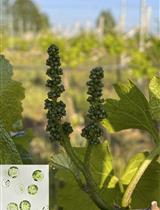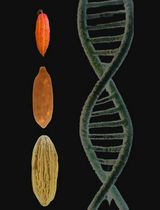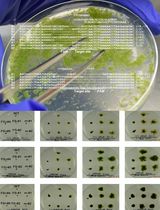- EN - English
- CN - 中文
An Effective and Safe Maize Seed Chipping Protocol Using Clipping Pliers With Applications in Small-Scale Genotyping and Marker-Assisted Breeding
一种高效安全的玉米种子切削方案:基于切削钳的小规模基因分型和标记辅助育种应用
发布: 2025年02月05日第15卷第3期 DOI: 10.21769/BioProtoc.5200 浏览次数: 1812
评审: Samik BhattacharyaAnonymous reviewer(s)
Abstract
In applications such as marker-assisted breeding and positional cloning, tissue sampling and plant tracking are vital steps in the genotyping pipeline. They enable the identification of desirable seedlings, saving time and reducing the cost, space, and handling required for growing adult plants, especially for greenhouses and winter nurseries. Small-scale marker-assisted selection laboratories rely heavily on leaf-based genotyping, which involves over-planting large, segregating populations followed by leaf sampling, genotyping, and backtracking to identify desired individuals, which is costly and laborious. Thus, there is a need to adopt seed-based genotyping to reduce costs and save time. Therefore, we developed a safe and cheap seed-chipping protocol using clipping pliers to chip seeds to genotype before planting. To identify a cost-effective and high-throughput DNA extraction method, we tested four extraction methods and assessed the quality of the seed DNA using PCR. For three of the methods, seed-based DNA was of comparable quality to DNA extracted from leaf punches. We also compared seed- and leaf-derived DNA from the same individuals in a segregating population to test for genotyping miscalls that could arise due to the presence of maternally derived pericarp in the seed samples. Out of 43 potential instances, we found zero miscalled samples and, therefore, no evidence supporting consequential pericarp inclusion. Germination rates of chipped and unchipped seeds were the same for the inbreds tested, B73 and Mo17. However, chipped seeds grew slower until ~14 days after sowing. Overall, seed sampling using clipping pliers provides a simple, reliable, and high-throughput method to identify specific genotypes before planting.
Key features
• Provides a quick, safe, and cheap sampling technique for maize kernels that may also be suitable for other plants with relatively large seeds.
• Includes procedures and materials to track and organize samples within and across batches involving tens to thousands of seeds.
• Seeds can be sampled and genotyped relatively quickly for planting; in one day, 384 seeds can be sampled, processed for DNA, and genotyped by PCR.
Keywords: Maize (玉米)Background
Over the last decades, marker-assisted selection (MAS) has become integral to most plant breeding systems because quantitative trait loci (QTL) and molecular markers linked to desired traits have enhanced the selection efficiency of desirable plants and shortened breeding cycles [1]. Unlike commercial breeding companies with highly automated and streamlined MAS and trait-discovery programs, public-sector breeding programs and small-scale genotyping laboratories rely on laborious and time-consuming tissue sampling and DNA extraction procedures [2]. Compared to the proprietary seed-based MAS programs utilized by industry scientists, public-sector genotyping systems that rely heavily on leaf-based DNA genotyping may be particularly resource- and time-demanding [1] as the marker genotyping process must be coupled to the sowing and germinating of seeds, caring for seedlings, tracking of live plants to static samples, and the immediate interpretation of data in order to identify, retain, and rear the desired, growing plants for their intended purpose. Thus, to improve the efficiency of MAS and related approaches, there is a need to adopt seed-based genotyping as a separate, pre-planting process, which reduces overall labor costs and saves space and time through selection of desirable genotypes during the off-season [1,2]. During trait discovery, seed-based DNA genotyping ensures that seeds with desirable traits are selected and planted, thus saving time and costs associated with greenhouse use and winter fields. In addition to tissue sampling, optimizing rapid and cost-effective DNA extraction methods to screen large populations will be essential for a successful MAS and genotyping pipeline.
Seed-based DNA genotyping methods have been implemented in small-scale maize breeding programs and genotyping laboratories but are still ineffective based on safety and scalability [2,3]. One seed-based DNA genotyping method is based on soaking maize kernels in water before endosperm chipping [2]. The caveats of this procedure include susceptibility to fungal contamination and low seed germination if kernels are not dried and stored well. Another common method uses a razor blade for seed chipping [3], which presents injury hazards and is time-consuming, thus making it impractical to quickly chip a large population. In this study, we used clipping pliers, a safe alternative to previous chipping methods that is scalable to high-throughput applications. This seed-chipping method did not significantly impact germination rates for maize B73 and Mo17 seeds, although seedlings from chipped seeds had reduced vigor that was evident for 14 days after planting, after which they appeared comparable to their non-chipped sibling seedlings. In addition, we tested four DNA extraction methods, based on each of cetyltrimethylammonium bromide (CTAB) [4], sodium dodecyl sulfate (SDS) [5], urea [6], and guanidine hydrochloride [7], and optimized a cost- and time-efficient DNA extraction protocol for maize endosperm samples.
Materials and reagents
Biological materials
1. Maize kernels (seeds)
Reagents
1. GoTaq GreenMaster Mix 2× (Promega, catalog number: M7123)
2. Dimethyl sulfoxide (DMSO) (Promega, CAS 67-68-5)
3. Betaine (Promega, CAS 107-43-7)
Laboratory supplies
1. 2.2 mL 96-well sample collection plates (n+1 plates for n sets of 96 tissue samples; see step A1) (VWR, catalog number 43001-0020)
2. 1.2 mL sampling tubes (96 for one set of 96 tissue samples, if using SDS or filter plate DNA extraction) (VWR, catalog number 83009-678)
3. 2.0 mL safe-lock microcentrifuge tubes (96 for one set of 96 tissue samples, if using CTAB DNA extraction) (Eppendorf, catalog number 022363352)
4. Labeling tape
Equipment
1. Forceps (VWR, catalog number 82027-446)
2. Pet nail clipping pliers (Resco, catalog number: PF0728); see General Note 1
3. Mini ice cube tray, used for seed storage, 135 cubes per tray 0.5 inch size (e.g., Source 1 or Source 2).
Software
1. Tissue Sample Plate Mapper software; available as a Google sheet plug-in (Google Workspace
Marketplace, plug-in number: 115639436496)
2. Excel or other spreadsheets may be useful for additional notetaking
3. Primer3 software (https://bioinfo.ut.ee/primer3-0.4.0/)
4. MaizeGDB (http://www.maizegdb.org) for primer blast analysis
Procedure
文章信息
稿件历史记录
提交日期: Apr 4, 2024
接收日期: Dec 5, 2024
在线发布日期: Jan 9, 2025
出版日期: Feb 5, 2025
版权信息
© 2025 The Author(s); This is an open access article under the CC BY-NC license (https://creativecommons.org/licenses/by-nc/4.0/).
如何引用
Zebosi, B., Ssengo, J., Geadelmann, L. F., Unger-Wallace, E. and Vollbrecht, E. (2025). An Effective and Safe Maize Seed Chipping Protocol Using Clipping Pliers With Applications in Small-Scale Genotyping and Marker-Assisted Breeding. Bio-protocol 15(3): e5200. DOI: 10.21769/BioProtoc.5200.
分类
植物科学 > 植物分子生物学 > 遗传分析
分子生物学 > DNA > DNA 提取
您对这篇实验方法有问题吗?
在此处发布您的问题,我们将邀请本文作者来回答。同时,我们会将您的问题发布到Bio-protocol Exchange,以便寻求社区成员的帮助。
Share
Bluesky
X
Copy link












